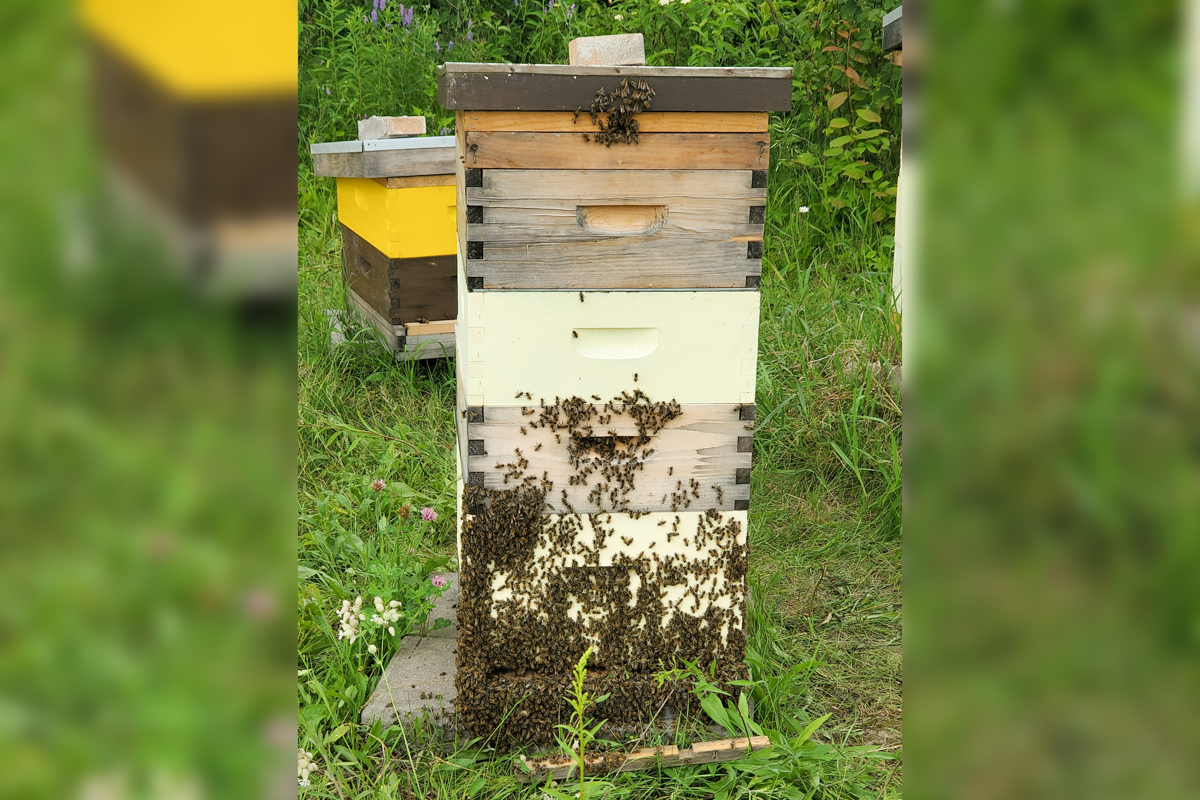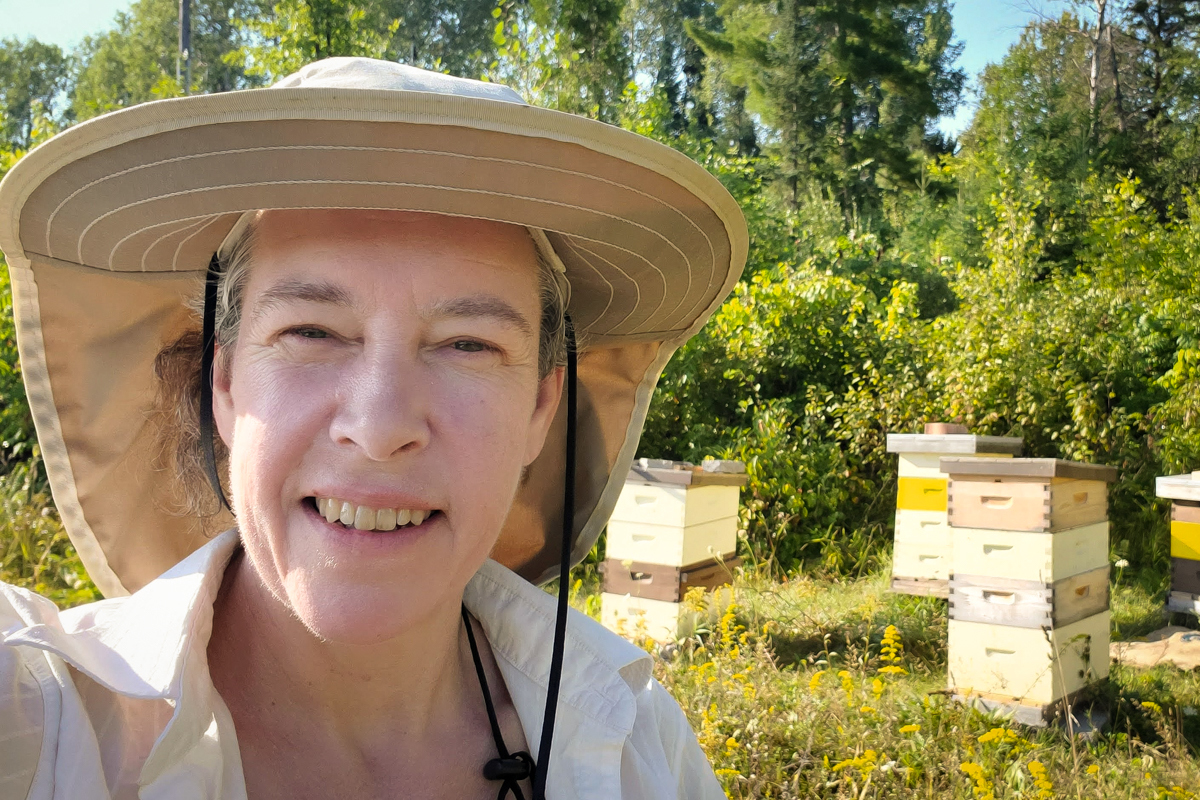It was almost 9 p.m. one warm June evening on beekeeper Dinah Robinson’s four-acre cottage in Douglas, Ont., when suddenly, a familiar high-pitched hum cut through the night. The world stilled and Robinson watched with fascination as thousands of her honeybees fled their hive. Their wings shone like bits of chrome in the darkness illuminated by the moonlight. The Bytown Bees owner had never before witnessed the phenomenon but recognized it immediately as a swarm. Nearly 20,000 bees were leaving the colony they had outgrown, in search of a new home.
“It is a magical experience,” Robinson said. “I stood in the middle of them, and they were oblivious to me. It was noisy, a beautiful chorus of bees.”
The bees’ flight quickly came to an end as the colony took refuge around six meters up a nearby tree bordering Robinson’s yard. Equipped with the knowledge from her own research and time as a student in Algonquin College’s beekeeping program, she rushed to her shed to grab a ladder and catch the swarm.
Catching the swarm means Robinson must don protective gear and gently capture handfuls of bees, placing them in a box until enough have been collected for the rest of the colony to begin to follow.
If she failed to act quickly, the bees might have left and Robinson would have lost the opportunity to retain and bolster her apiary. However, in her moment of need, Robinson was surprised to discover the ladder she thought was in her shed was missing. Out of desperation, Robinson turned to her own hive for help: the beekeepers of Eastern Ontario and Western Quebec Facebook group.
“It turns out there’s always a beekeeper hiding somewhere nearby,” she said.
A fellow beekeeper who lived about half an hour away came to Robinson’s aid that night. With the help of a big truck and a long extension ladder, the pair caught the swarm.
“My new friend was a superhero,” Robinson said. “We got stung by bees and mosquitoes galore, but it was worth it.”
For Robinson, the successful catch was a necessary win to help her hive recover after a rough spring. She lost all nine of her colonies because of a varroa mite infestation, leaving her to rebuild with eight new colonies. Challenges aside, Robinson harvested 150 kilograms of honey in 2022 from her small farm.
“In Ontario, we had [major] losses of honeybee hives because [irregular seasonal patterns allowed] the varroa mites to have an extra breeding cycle,” Robinson said. “Their population grows through the winter whereas the honeybee population shrinks before the winter, so lots of people lost their colonies to varroa mites last winter.”
The parasitic mite is labeled by the Ontario Ministry of Agriculture as the most serious threat to honeybees. A recent study by the University of Maryland states that the mite is one of many risk factors threatening the mortality of honeybees. The study used mathematical modeling to show how the lifespan of adult honeybees appears to have shrunk by around 50 per cent over the past 50 years. While investigating water supply in cage studies—a method that uses caged bees to reflect domesticated beekeeping—the researchers found that since 1969, the lifespan of adult honeybees has dropped in the U.S. from an average of 34 days to just 18 days.
The authors observed several environmental stressors in a laboratory setting, including how modern honeybees are weakened by the increased use of pesticides. They also found honeybees are suffering from higher rates of disease, such as deformed wing virus, which has become more common since the global spread of varroa mites in the 1980s.
Even more surprising is the conclusion by the study’s authors that this overall decline in honeybee lifespan could be because of an independent genetic factor. Artificial or natural selection may favour bees with a shorter life span because a live-fast-die-young lifestyle is better equipped to survive the increasingly relevant stressors of the modern world.
“The period of time [the study] is talking about, from the seventies until now, we’ve had the most greenhouse gas emissions, the highest use of pesticides, and some of these things are maybe having a genetic impact,” Robinson said. “Fifty years is only a few generations of humans, but for insects, it’s a thousand times that.”

Cage bees versus free bees
Research into bee lifespan is critical in the effort to save honeybees, which Robinson characterizes as the engine of our food supply. The more information beekeepers have about the unexplained high rates of bee colony deaths being reported around the world, the more they can do to maintain or increase their lifespan, she said. However, while Robinson admits to finding the results of the study shocking, she says laboratory observation may not paint a full picture of the behaviours of honeybees in nature that enhance their health and wellness.
Rob Currie, head of the Bee Lab at the University of Manitoba, echoed the limitations of the Maryland study. He explained many factors can influence the longevity of bees studied in cages, such as whether they are fed pollen, the number of bees in the cage, the type of sugar syrup that they consume and where the bees are located.
“What they’ve shown is that there seems to be somewhat of a relationship between survival declining over time, but they’ve only shown it in the U.S. They didn’t look at any colonies outside of the U.S.,” Currie said.
Some historical records of lab-kept bees suggest they share a similar lifespan to colony bees and every lab in Canada that does bee research uses caged bees. But, he emphasizes, this methodology comes with its share of blind spots. It’s a stretch to suggest that genetics are responsible for the observed difference in longevity. In the U.S., the breeding process might be more concentrated than it is in different areas of the world.
“They tend to have these very large commercial operations and large queen-rearing operations that sell queens to producers. So, the genetic diversity in that population might be a lot lower than it might be in, say, Europe or possibly even in Canada,” Currie said.
Despite his criticism, he is quick to say that the research reveals an interesting observation that requires a closer look. The issue of declining bee health is the subject of several ongoing research projects in Canada, where honeybees contribute up to $5.5 billion a year to the agro-economy through crop pollination.
Honeybees have been declining over the past decade, with Canadian beekeepers losing more than a quarter of their colonies each winter since 2006. Currie is part of a team of Canadian researchers working on a project launched in October 2019 to equip beekeepers and government regulators with an objective means to diagnose and differentiate the multiple stressors impacting colonies.
In an effort to improve the well-being of Canada’s bees, the team is developing a new health assessment and diagnosis platform powered by stressor-specific markers for honeybees called BeeCSI.
“There’s a lot of work going on in Canada trying to determine the causes of what the major stresses are on bees and the means to mitigate those stresses,” Currie said.
The advancement of scientific innovation to save the bees is supported by smaller grassroots efforts. In 2019, Robinson launched a local petition to make Ottawa a Bee City and gathered over 27,000 online signatures. To be a Bee City, the capital needs to make a series of pollinator-friendly municipal commitments, such as initiatives developing greenspace and raising awareness about planting native vegetation.
Following Robinson’s petition, City of Ottawa staff researched the requirements needed to add Ottawa to the list of bee-friendly Canadian cities, which includes other municipalities such as the City of Toronto.
According to a report from the Standing Committee on Environmental Protection, Water and Waste Management in April 2019, the motion to become an official Bee City was rejected by the City of Ottawa because it would “create new administrative requirements without providing commensurate benefits to the City.”
The report states the city would rather continue putting work into other actions such as community gardens and its Official Plan than divert resources towards becoming recognized as an official Bee City.
Despite the lack of official recognition, Robinson hasn’t stopped advocating for pollinator protection. Instead, she’s focused on raising community awareness through her work with community gardens and as a board member of the Community Associations for Environmental Sustainability (CAFES). During the CAFES Earth Day event in September, Robinson said the community engagement was palpable. She remembers speaking with children who shared their knowledge about bees and humans’ food supply.
“I think the best thing in terms of longevity is young children that are so enthusiastic about bees and plants,” Robinson said. “I know that they’ll be the generation that will be communicating about this and doing things to save and replenish habitat in our community.
Featured image by Dinah Robinson.






